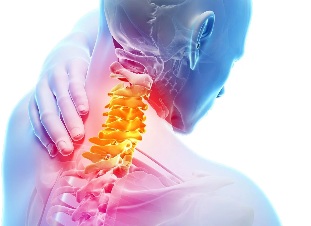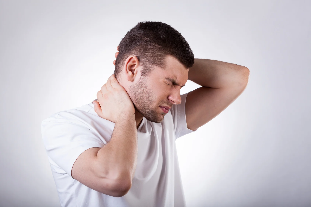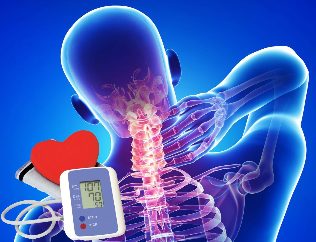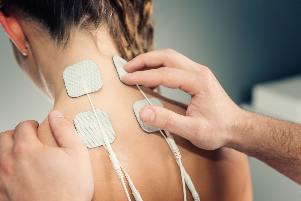Cervical osteochondrosis is a certain amount of degenerative changes in the intervertebral discs in the neck area.

Negative not only the discs themselves but also the vertebrae, soft and cartilage-building needs are affected. The main feature of the cervical spine is the fact that its vertebrae do not have the most reliable figure in comparison to other departments, which makes this area very vulnerable. is The vertebrae are in close proximity to each other, but also on the arteries that the nutrition of the human brain.
If there is a displacement of the vertebral body, then the likelihood is great constriction of the nerve bundle and arteries, which will inevitably lead to the emergence of hernia between the vertebrae, and a protrusion, i.e., changes in the structure of the intervertebral disc.
What is it?
Osteochondrosis of the cervical spine (Osteohondroz) is a degenerative-dystrophic lesions of the intervertebral discs, in consequence of which self-drives, the spine vertebrae and joints of the neck are damaged, a decrease in the height of the intervertebral discs. The disease progresses if untreated, and may cause incidents, headaches, circulatory disorders, and even intervertebral disc. Such as osteoporosis, the disease occurs due to the violations of the mineral metabolism, which bone to use and the joints are less strong.
Osteochondrosis can have instability of the cervical spine (symptoms and treatment similar to chondrosis, but have a number of properties), which is not rarely accompanied by a displacement of the vertebrae. This in turn accelerates disease is the development of degenerative intervertebral disc, the destruction of the spinal Department.
Stage
The treating physician should determine the diseases the degree of development of cervical degenerative disc, based on the anamnesis and examination of the patient. We distinguish four grades:
- Of the first degree. The disease is in the germ, the Patient with a slight pain in the neck, perhaps more intense when the human being begins to turn your head.
- Of the second degree. The Patient may complain of very severe pain in the cervical spine, which are localized in the upper extremities. The clinical picture shows that at this stage of the development of the diseases observed trapped nerve bundles, and causing intense pain. There will also be headache, weakness and General General feeling pointed out.
- In The Third Stage. Pain is almost constant, also in the shoulder or Hand. In some patients, disc herniation is diagnosed, that leads to the loss of sensitivity of the upper extremities. In the case of the investigation of the doctor, there was a significant reduction in the mobility of the cervical spine, as well as pain on Palpation.
- The fourth stage. In this stage of the disease the intervertebral disc is almost completely destroyed. In its place, the connective tissue appears, which leads to a deterioration in the condition of the patient. He begins, more pain, ringing in the ears, and poor orientation in space. This suggests that the artery turns out to be pinched, which prevents the natural diet of the brain.

Symptoms of degenerative disc disease of the cervical spine
Important symptoms of osteochondrosis of the cervical spine, dizziness, headache, horse racing blood pressure.
Diagnosis of the disease difficult, sometimes pain is not shown, and the symptoms of the deleted characters is wearing, to the uncontrolled use of strong pain medications, the signs of the disease concealed. The Patient does not feel pain, feels healthy, and so it goes, until the development of irreversible processes in the tissues of the joints of the neck.
Headaches with cervical osteochondrosis
It is one of the most common non-specific symptoms of many diseases of the people. Headaches particularly prevalent in the female population. It is difficult to determine the cause of headaches, and, above all, they bind with changes in the spine. About 14 different causes for headaches in people.
The most common causes of headaches in the described pathology us:
- Spasm of cerebral vessels;
- Pinched Nerve Roots;
- Reflex increased intracranial pressure.
Headaches with cervical osteochondrosis sensations were, remind can high blood pressure, Angina, or stroke. Especially in people of middle and higher age, in General, about the risks of strokes or heart attacks.
Perceived pain may be paroxysmal, constant, pulsating and stupid.
In the case of pathologies of the heart, patients complain of discomfort in the area of the chest, accompanied by a rhythm disturbance of the heart activity. To determine the cause can only be made by a qualified physician. In the case of a headache, coupled with nausea, dizziness, and retro-sternal pain, not necessarily an ECG is made.

Dizziness with cervical osteochondrosis
Such a condition has spine clear evidence of osteochondrosis of the neck.
Dizziness can be the result of:
- Inflammation in the middle ear, the inner ear;
- Spasm of cerebral vessels;
- Violation of transmission of nerve impulses;
- Problems with vestibular apparatus;
- Diseases of the circulatory System.
There are no exact criteria dizziness osteochondrosis. However, there is the common dizziness, they have significant differences.
It is recommended to know the differences between the systemic and dizziness-system, it will help to independently determine the causes of unusual conditions:
- Systemic dizziness is a feeling of circular movement of the surrounding objects or the body, which is a consequence of disorders of the vestibular, visual analyzers and receptors in the joints, muscles and the Epidermis (osteochondrosis of different etiology);
- No System of dizziness is a feeling of powerlessness, a feeling of numbness, unsafe condition in an upright Position. In the case of non-systemic dizziness, feeling of circular Rotation, and this is an important difference to the comparison of the signs is missing.
The man, feeling dizzy, one of these types must be regarded, by an experienced doctor, primarily a neurologist or (if there is a suspicion of disease of the ear, nose and throat) ENT.
The reason for the emergency room in a hospital in connection with osteochondrosis of the cervical spine, is the identification of the patient (except for fraud), such characteristics, such as:
- Paralysis of the face muscles and numbness of part of the shoulder girdle;
- Severe headache against the background of the deterioration of the health;
- Lack of coordination of movements;
- The loss of, or the extinguishing of consciousness.

Blood pressure with cervical osteochondrosis
The connection of cervical degenerative disc disease installed with irregular blood pressure a long time ago. The cervical vertebrae have important nerves and blood vessels.
Characteristic pressure peaks in the course of the day. Hypertension for a long time not typical for this disease. Reflex irritation of the nerve endings, and transient spasms of the blood vessels can cause hopping of the daily dynamics of the arterial high blood pressure.
A distinctive feature of the increased pressure in the cervical osteochondrosis in combination with the following symptoms:
- Headaches;
- Pain in the extremities and the chest;
- Sensitivity reduction in the area of the neck area;
- The formation of pressure shocks according to Stress, muscle tension, a long time in an uncomfortable Position, and other similar situations.
These characteristics must be taken into account in the self-differentiation of arterial hypertension of different Genesis.
Fluctuating blood pressure and the rapid deterioration of health are the basis for the treatment for urgent medical help.
Syndromes of osteochondrosis
The clinical picture of cervical degenerative disc disease in several syndromes. Syndrome there are some symptoms that occur together.
Osteochondrosis consists of one from the following syndromes:
- Eddy. It is also means as the spine, which, in the pathological process of bone are involved in the use and cartilage. This spine leads to the formation of such symptoms: restriction of motor activity of the neck, pain on curves, radiological changes on x-ray image of the neck. Precisely the simultaneous appearance of these characters is-spine-syndrome. A similar set of clinical signs observed with Myositis (pathology of muscle tissue), and painful motion companion of many other pathologies.
- Syndromes Of Spinal Arteries. Appears to be with the involvement in the process of the according to bundle, the provider is responsible for the blood supply of tissues of the Central nervous system. Symptoms to say that brain tissue have stopped, you will get the right amount of nutrients. How to recognise this syndrome? The first signs of dizziness, sensation of Tinnitus, changes in blood pressure, the emergence of the "veil" before the eyes. This States that one of the vertebral arteries located in stavlennia condition. Each ship has its nerve. When pressed, Innervate the spinal artery, migraine, numbness, temporary decrease of sight on one side. In the end, changes in the vessel cause the brain needs oxygen. In this time, the Person feels dizziness, transient disturbances of consciousness, loses the attention and control, bad runs, and stores information. In the case of this clinical picture to differentiate cervical osteochondrosis with atherosclerosis of spinal arteries, the feeling of pressure Tumor or inflammation must.
- Cardiac Syndrome. Burning in the chest manifested,the appearance of shortness of breath. The man feels his heartbeat, is tired and irritable. This pattern is characteristic and for the cardiological pathologies, for example, for Angina, coronary syndrome, heart attack. Accurate conclusion about the causes of such signs may, after the Patient ECG.
- Radicular Syndromes. The neck portion innervates 8 nerve pairs, each of which has nerve roots in place, the neuro-foramina vertebra. At the time of their participation in the osteochondrosis, the Patient is the decrease in the sensitivity or, on the contrary strong the pain feels. It can neck to numbness feeling, whether its pain, decrease in the sensitivity of the tongue, the area behind the ear, pain in the supraclavicular area. Sometimes there is difficulty in swallowing, movements in the belt of the upper extremity, numbness of the fingers.
First aid in the home in the event of aggravation of osteochondrosis
In the case of severe pain syndrome pain can apply resources, such as AnalGin, Tempalgin, or Baralgin. If the above medicines do not bring relief, can NSAIDs (nise, or Diclofenac) are accepted.
Often disturbing" means, for example, pepper-Patch that does not heal, but only the inflamed area be used "and distracts from the pain. In the case of the formation of edema in the area of inflammation, the Patient, the Infusion of herbs or diuretic drink for 3-4 days. Can I use to heal a bone with such methods? These measures are only visiting temporarily, for the treatment of the causes a doctor.
Take note of which doctor treated osteochondrosis. If you should diseases of the suspicion that the causes of pain in the cervical spine, the incidence of degenerative intervertebral disc, contact a neurologist. It is this specialist deals with the diseases of this kind. In some hospitals, there is a narrowly focused specialists, the diseases, especially of the spine. If in your clinic, there are wertebrolog, should the question of how to cure this disease immediately to him.

How to treat osteochondrosis of the cervical spine?
In the initial phase of development pain can heal in the lower back without medicines, enough to rethink diet, daily routine, regularly hosts a series of special exercises. At the started forms of the disease effective treatment is only possible if the application of various drugs, with which to suspend the degenerative changes in the vertebrae.
In the complex of therapeutic measures physiotherapy – electrophoresis with drugs, ultrasound, magneto therapy, laser therapy is a must. These methods will help with pain, inflammation, swelling of tissues, improves metabolism and blood circulation.
Drug Treatment
The main methods of treatment of degenerative disc disease of the cervical spine is a medical treatment, physical therapy, Massage neck and neck area, particularly effective therapeutic exercises with cervical osteochondrosis. The main groups of drugs that belong in this disease:
| Title | Function principle |
| Non-steroidal anti-inflammatory drugs (NSAIDs). Voltaren, nise, Movalis, ketonal, ketanov, diclofenac, nimesulide, and others | Reduce pain, promote the elimination of aseptic inflammation and swelling of the spine of the injured nerve. |
| Drugs for improving the flow properties of blood and blood circulation. This is aminophylline, trental. | Improve roots, the supply of damaged nerves and improve the blood flow to the brain. |
| B-vitamins Is kombilipen, unigame, mil ' Gamma, neurobion. | Improves metabolic processes in the nervous tissue. |
| Muscle relaxants. It mydocalm, sirdalud, chiseled, tizanidine, etc. | These medications, muscle cramps. |
| Chondroprotectors. It is (glucosamine and chondroitin sulfate) artra, terafleks, doppelgerts, toad stone, Andro Nova, structovis, alflutop. | These drugs, cartilage regeneration, including in the damaged intervertebral disc. |
Taking the tablets of the osteochondrosis, to take into account that there is a significant effect of drug treatment of tablets is only in the case if you compare it with other methods, including exercises. It is also necessary to note that the doctor should prescribe, to treat as a disease, due to their stage and other characteristics.














































